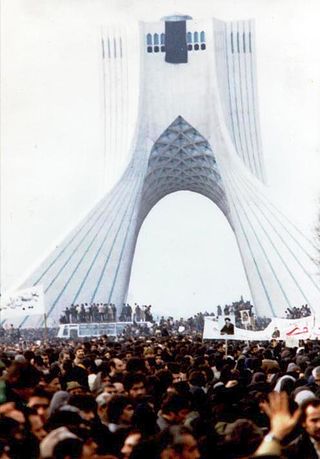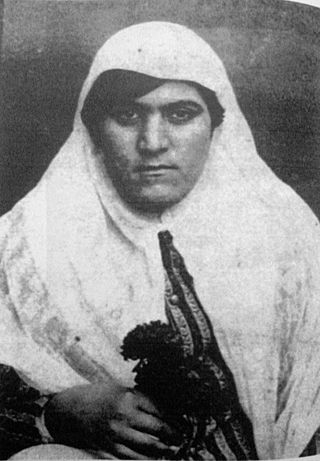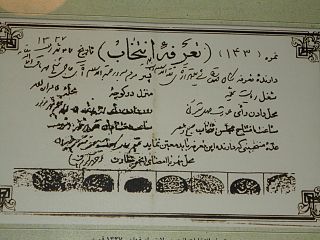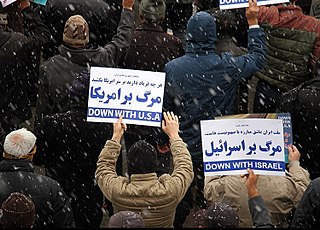
This article is a timeline of events relevant to the Islamic Revolution in Iran. For earlier events refer to Pahlavi dynasty and for later ones refer to History of the Islamic Republic of Iran. This article doesn't include the reasons of the events and further information is available in Islamic revolution of Iran.

Saint Mary Church, Holy Mother of God Church or Surp Mariam Asdvadzadzin Church is an Armenian Apostolic church in Tabriz, East Azerbaijan Province, Iran completed in 1785. It is the largest and oldest Christian church in Tabriz and a notable centre for Armenian national and religious ceremonies held by the Armenian community of Tabriz.

Ahmad Khan Daryabeigi was an Iranian military officer and educator.

Zainab Pasha was an Iranian woman who lived during the Qajar dynasty in late 19th century. She is most notable for her role in the Tobacco Protest, the beginning of the Constitutional Revolution of Iran, for leading a group of women in an uprising in the city of Tabriz by attacking wealthy merchants. This led to the closure of the Tabriz Market.

The Isfahan National Holy Association was the main political and decision-making bureau of Isfahan, Iran during the first Persian Constitutional Revolution period. The members of the council were elected by the people of Isfahan and Nurollah Najafi Isfahani chaired the council. The association was formed between years 1906 and 1908, namely from the migration of Qom to the 1908 bombardment of the Majlis at the Fort of Chehel Sotoun in Isfahan.
Mohammad Doroudian is an Iranian writer, historian, researcher and theorist. Doroudian was born on 1959 in Tehran, and actively writes about the history of the Iran-Iraq War. He holds a BA in History from Shahid Beheshti University. More than seventeen books have been published by Mohammad Doroudian so far. He is one of the elect of the 31st Iran's Book of the Year Awards and the winner of the 8th Holy Defense Year Book Award.
Saints Thaddeus and Bartholomew Church of Tehran,, is an Armenian Apostolic church in Tehran, Iran. It is the oldest church in Tehran.

Bibliography of Rasul Jafarian is a list of books published by Rasul Jafarian, cleric, translator, writer and researcher of Iranian history.
The Religio-political currents and organizations in Iran is a Persian book by the Iranian author, Rasul Jafarian. The book describes the cultural and political events of Iran from the time of Mohammad Reza Pahlavi to the victory of the Islamic Revolution. More than 65 explanatory and critical notes have been written on this book. In the third edition of this book Ali Khamenei, Supreme Leader of Iran, wrote a note on the book's chapter that had written about Ali Shariati. The book has been reprinted over twenty times.
This is a list about all badges of honor in Iran. The list contains badges and medals of the monarchy and government of the Qajar dynasty, Pahlavi dynasty and Government of the Islamic Republic of Iran which have special ratings and classes.
The Housing Foundation of Islamic Revolution was established on April 10, 1979, by the order of Ruhollah Khomeini, the founder of the Islamic Republic of Iran, to provide housing for the deprived and to be responsible for the development of the country's villages and the construction of urban housing units within the policies and programs of the Islamic Republic of Iran.
Sadegh Sadrieh (Persian: میرصادق صدریه; was a prominent Iranian politician and diplomat who served as Foreign Ministry Office counselor and as ambassador during the Pahlavi era.

The policy of exporting the Islamic Revolution is a strategy in Iran's foreign policy that believes in exporting the teachings of the Iranian Revolution of 1979 to achieve similar examples in Islamic and even non-Islamic countries. This policy has been explicitly and at various times announced by Ruhollah Khomeini, the founder of the Islamic Republic of Iran. One of the basic slogans of the Islamic Revolution of Iran is the export of the revolution. Accordingly, the purpose is exporting the revolution as a culture, ideology and an intellectual and epistemological method.
Seyyed Qutb al-Din Mohammad Neyrizi was a prominent Iranian mystic of the Safavid period. He was 32nd Qutb of Zahabiya genealogy. All historians have written his name as Mohammad and his title as Qutb al-Din. In addition to his high position in the history of Shiite mysticism, he was one of the most important and influential political thinkers of the late Safavid period.

Zahabiya Sufism is a Shiite order. The history of dervishes from this order dates to the third century AH and Ma'ruf al-Karkhi. Some believe that the order originated during the ninth century AH in Iran; it first became popular in Khorasan and then in Shiraz during the early Safavid period.
The history of the parliament in Iran refers to the history of this legislative body in Iran, which has gone through various stages. This legislative body has been changing and expanding from a 25-member House of Expediency to the present day, which operates under the name of the Islamic Consultative Assembly with 290 members.

The United States Cultural Diplomacy in Iran refers to the use of soft power of cultural diplomacy by the US government towards Iran in order to achieve its own interests.

Iran Between Two Revolutions is a book by Ervand Abrahamian that was published in 1982 by Princeton University Press.

Foucault in Iran: Islamic Revolution After the Enlightenment is a book by Iranian-born American historian, sociologist, and professor Behrooz Ghamari-Tabrizi as a groundbreaking reassessment of Michel Foucault's writings specially on the Iranian revolution.

This article deals with political slogans of Islamic republic era in Iran.













